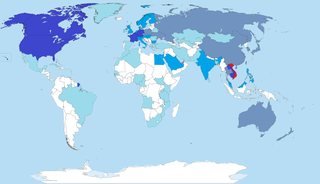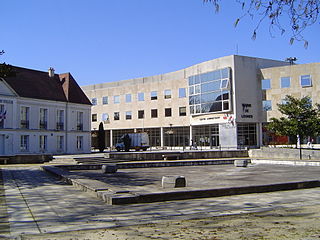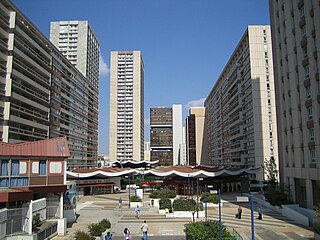
French Indochina, officially known as the Indochinese Union and after 1947 as the Indochinese Federation, was a grouping of French colonial territories in Mainland Southeast Asia until its demise in 1954. It comprised Cambodia, Laos, the Chinese territory of Guangzhouwan, and the Vietnamese regions of Tonkin in the north, Annam in the centre, and Cochinchina in the south. The capital for most of its history (1902–1945) was Hanoi; Saigon was the capital from 1887 to 1902 and again from 1945 to 1954.

The 13th arrondissement of Paris is one of the 20 arrondissements of the capital city of France. In spoken French, the arrondissement is referred to as le treizième.

Urban Chinatowns exist in several major European cities. There is a Chinatown in London, England, as well as major Chinatowns in Manchester, Birmingham, Newcastle and Liverpool. In Paris there are two Chinatowns: one where many Vietnamese – specifically ethnic Chinese refugees from Vietnam – have settled in the Quartier chinois in the 13th arrondissement of Paris which is Europe's largest Chinatown, and the other in Belleville in the northeast of Paris. Berlin, Germany has two Chinatowns, one in the East and one in the West. Antwerp, Belgium also has an upstart Chinese community.

Overseas Vietnamese refers to Vietnamese people who live outside Vietnam. There are approximately 5 million overseas Vietnamese, the largest community of whom live in the United States.

The city of Paris had a population of 2,165,423 people within its administrative city limits as of January 1, 2019. It is surrounded by the Paris unité urbaine, or urban area, the most populous urban area in the European Union. In 2018 the unité urbaine had a population of 10,816,803 in 2,854 km2 (1,102 sq mi). The Paris Region, or Île-de-France, covers 12,012 km2 (4,638 sq mi), and has its own regional council and president. It has a population of 12,213,447 as of January 2018, or 18.3 percent of the population of France. The metropolitan or functional area of Paris covers 18,941 km2 (7,313 sq mi) and has 13,064,617 inhabitants (2018).
The Indochina Wars were a series of wars which were waged in Indochina from 1945 to 1991, by communist Indochinese forces against the opponents. The term "Indochina" originally referred to French Indochina, which included the current states of Vietnam, Laos, and Cambodia. In current usage, it applies largely to a geographic region, rather than to a political area. The wars included:

Army and warfare made their first appearance in Vietnamese history during the 3rd millennium BC. Throughout thousands of years, wars played a great role in shaping the identity and culture of people inhabited the land which is modern day Vietnam. Vietnam is regarded as one of the most militaristic countries in Southeast Asia, there is even a higher level belief Vietnam might be the most militaristic nation in Southeast Asia, and one of Asia and the world's most militaristic countries. The military history of the Socialist Republic of Vietnam began when Japan invaded French Indochina and soon defeated the French resistance. Since then, Vietnam has fought in many conflicts in Indochina.
Asian Argentine, are Argentine citizens or residents of Asian ancestry. The vast majority trace their ancestry to West Asia, primarily Lebanon and Syria, and East Asia, namely China and Japan. Though there are other communities of South Asian or Southeast Asian origin as well. Asian-Argentines settled in Argentina in large numbers during several waves of immigration in the twentieth century.
Cambodians in France consist of ethnic Khmer people who were born in or immigrated to France. The population as of 2020 was estimated to be about 20,000 making the community one of the largest in the Cambodian diaspora. The Cambodian population in France is the most established outside Southeast Asia, with a presence dating to well before the Vietnam War and subsequent Indochina refugee crisis including the horrors of Pol Pot and the Khmer Rouge who took over in Phnom Penh on 17 April 1975. A few numbers of Cambodian people were able to escape and migrate to France before the Khmer Rouge took power in Cambodia as the Cambodian Civil War came to an end and overthrow U.S.-backed military dictatorship of Lon Nol and the Khmer Republic. His brother Lon Non and the other Khmer officials were arrested and executed by the CPK, the Marxist-Leninist dictatorship that seized power in Phnom Penh. 13 days before the Fall of Saigon and the Second Indochina War ended on 30 April 1975.

Lognes is a community in the eastern suburbs of Paris, France. It is located in the Seine-et-Marne department in the Île-de-France 20.7 km (12.9 mi) from the center of Paris.

The largest of the ethnic groups in Cambodia are the Khmer, who comprise approximately 90% of the total population and primarily inhabit the lowland Mekong subregion and the central plains. The Khmer historically have lived near the lower Mekong River in a contiguous arc that runs from the southern Khorat Plateau where modern-day Thailand, Laos and Cambodia meet in the northeast, stretching southwest through the lands surrounding Tonle Sap lake to the Cardamom Mountains, then continues back southeast to the mouth of the Mekong River in southeastern Vietnam.
The Chinese diaspora in France consists of people of Chinese origin who were born in or immigrated to France. The ethnic Chinese population in France is estimated to be about 100,000-150,000, making it the largest overseas Chinese community in Europe.
Turks in France also called the Turkish-French community, French Turks or Franco-Turks refers to the ethnic Turkish people who live in France. The majority of French Turks descend from the Republic of Turkey; however there has also been Turkish migration from other post-Ottoman countries including ethnic Turkish communities which have come to France from North Africa, the Balkans, the island of Cyprus, and more recently Iraq, Lebanon, and Syria. There has also been migration to France from the Turkish diaspora
Vietnamese people in France consist of people of full or partial Vietnamese ancestry who were born in or immigrated to France. Their population was about 400,000 as of 2017, making them one of the largest Asian communities in the country.
The Laotian diaspora consists of roughly 800,000 people, both descendants of early emigrants from Laos, as well as more recent refugees who escaped the country following its communist takeover as a result of the Laotian Civil War. The overwhelming majority of overseas Laotians live in just three countries: Thailand, the United States, and France.

As of 1990, the majority of Asians living in the Paris area were ethnic Chinese originating from several countries. The largest group includes ethnic Chinese from Indochina, and a smaller group originates from Zhejiang.

The Quartier asiatique, also called Triangle de Choisy or Petite Asie is the largest commercial and cultural center for the Asian community of Paris. It is located in the southeast of the 13th arrondissement in an area that contains many high-rise apartment buildings. Despite its status as a "Chinatown", the neighborhood also contains significant Vietnamese, Laotian and Cambodian populations.

Paris is home to the oldest Overseas Vietnamese community in the Western world and is also one of the largest outside Vietnam. There are an estimated 70,000 people of Vietnamese descent within the city limits of Paris as of 2018, with the greater Île-de-France area home to another estimated 100,000. Both figures make the Paris metropolitan area host to one of the greatest concentrations of Vietnamese outside Vietnam, if not the largest. They contains Vietnamese born- people that living in Paris (France) or French born-citizens of partially or full Vietnamese descent.

Sra peang is a rice wine stored in earthen pots and indigenous to several ethnic groups in Cambodia, in areas such as Mondulkiri or Ratanakiri. It is made of fermented glutinous rice mixed with several kinds of local herbs. The types and amount of herbs added differ according to ethnic group and region. This mixture is then put into a large earthenware jug, covered, and allowed to ferment for at least one month. The strength of this alcoholic beverage is typically 15 to 25 percent alcohol by volume.











